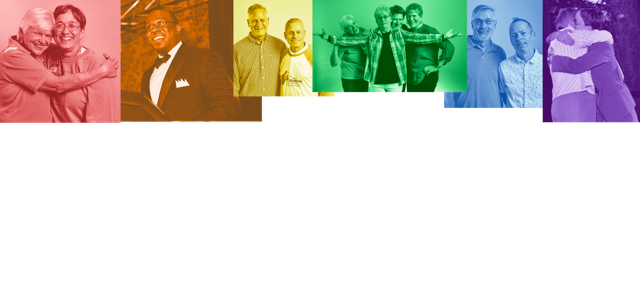Action in Rochester
From Campus to City Council
In the 1960s, Rochester's LGBTQ community kept to gay and lesbian bars and other underground places, but the Stonewall Uprising of 1969 galvanized students at the University of Rochester to organize for LGBTQ liberation, marking the beginning of LGBTQ activism in the city.
On October 3rd, 1970, after a meeting organized by University of Rochester (UR) students Bob Osborne and Larry Fine, with guest speakers from regional gay rights groups, the Cornell Gay Liberation Front (Ithaca, NY) and the Mattachine Society of the Niagara Frontier (Buffalo, NY), students formed the Rochester Gay Liberation Front (RGLF).1 Membership was open to students and Rochester residents, and Osborne used his experience organizing with the Civil Rights Movement to lead the group. In 1971, they began publishing The Empty Closet, Rochester's first LGBTQ publication, and later that year, UR allowed RGLF to host a gay dance on campus. In 1972, it organized Rochester's first annual gay picnic in July, which established the Rochester tradition of celebrating LGBTQ pride in July rather than June.
RGLF was remarkably successful; it was the only public source of positive visibility for LGBTQ people in Rochester and a source of community outside of bars and cruising scenes, embraced so much by Rochester residents that UR threatened to cut RGLF's funding, because students were the minority in the group. To address that imbalance, in a 1973 poll, members voted to split into an on-campus group, RGLF, and an off-campus group, named the Gay Alliance of the Genesee Valley (GAGV), which would take control of The Empty Closet and the annual gay picnic. The Gay Revolution of Women (GROW) also formed out of the split and moved off campus. Their move was advantageous to their growth and the voice of Rochester's LGBTQ community, because as community-based organizations, they had more freedoms to organize and receive funding.
GAGV's first battle with Rochester began during 1977, when it applied for government funding through the Comprehensive Employment and Training Act (CETA) to hire more staff. City councilman Charlie Schiano challenged GAGV's application, worried funding would promote homosexuality, and the Rochester Community Chest withdrew its offer to administer the grant, fearing they would lose funding if they did not. Fortunately, the Urban League replaced the Rochester Community Chest as the administrator of Rochester's CETA funds, and they reconsidered GAGV's application. During November 22, City Council voted eight to one (Schiano was the only opposition), and GAGV became the first Rochester LGBTQ organization to receive federal funding. The municipal and federal recognition of GAGV as a community organization was empowering for its purpose and affirmed LGBTQ Rochester residence as community members.2
Round two occurred when Rochester Area Chamber of Commerce President Thomas T. Mooney refused to rent the Chamber's banquet facilities to GAGV in 1983. He asserted that the Rochester community "does not condone the philosophy or morality that the Alliance espouses,"3 and in response to his claims, GAGV launched a campaign for an anti-discrimination ordinance. Within the year, Rochester City Council approved the ordinance, which banned discrimination based on sex, age, race, creed, and sexual orientation in city hiring and the provision of city services to the public.2 At that time, few cities offered such protections, and following the precedent set by Rochester, Kodak added "sexual orientation" to its Equal Employment Opportunity policy in 1984, followed by Xerox in 1990. Such public and private protections for LGBTQ people, in contrast to the popular unfit-for-employment narrative, helped to facilitate LGBTQ workplace activism in Rochester.
1 Bailey, “Shoulders To Stand On,” Out Alliance, October, 4, 2010.
2 a b Stonewall: 50 Years Out.
3 Wilson, “Gay Group Refused Use of Chamber.”
Workplace Activism
While grassroots, community activism in the 1980s set the stage for workplace activism in Rochester, employers and employees during the 1990s made it a reality. In 1992, employees at the two largest employers in the City of Rochester formed groups: Gays and Lesbians at Xerox (GALAXe) and the Lambda Network at Kodak (LNAK). They were like siblings, and in 1993 they co-hosted their first annual Holiday Gayla, a celebration for the Rochester Area Gay & Lesbian Business Community. In 1994, the Rochester City Council approved establishing a domestic partnership registry and providing domestic partnership benefits for city employees. In 1995, Xerox extended partial benefits to the domestic partners of its employees, and in 1997, Kodak extended full benefits. As a result of their work, Out & Equal chose Rochester to host the sixth Out & Equal national conference on LGBTQ workplace issues in 1998, affirming Rochester, Xerox, and Kodak as national role models of LGBTQ workplace equality.1
To learn more about LNAK's and Kodak's history, visit the Remembering the Lambda Network at Kodak exhibit.
1 Le Beau, “Out and Equal ’98 to Meet Here: The National Conference on Gay and Generder Workplace Issues Moves East.”

